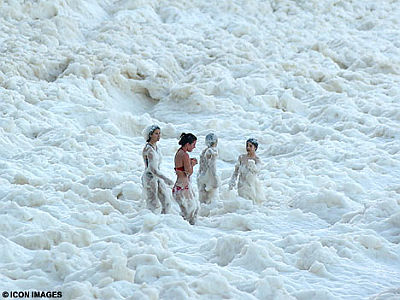A biologist investigates why the beef soup in the refrigerator suddenly turned blue

by Gerwin Sturm
Experiences such as ``the leftover food turned green due to mold'' are often reported, but you should not hear many reports that the food turned blue. An assistant professor of biological sciences at California State University San Marcos was surprised to find that beef soup in the refrigerator had turned blue and began investigating.
Microbiologist Investigates After Her Beef Soup Turned Blue In The Fridge | IFLScience
https://www.iflscience.com/microbiologist-investigates-after-her-beef-soup-turned-blue-in-the-freezer-67894
You can check the blue beef soup discovered by Mr. Erin Beckett, who specializes in biological science, from the following tweets. Since leftover food is reflected in this photo, it is necessary to be somewhat careful when viewing it, and Mr. Beckett also sets the photo as 'sensitive' content.
I can't believe y'all talked me into going back into the trash. pic.twitter.com/gn2aDtuhDN
— Dr. Elinne Becket @[email protected] (@bielleogy) March 1, 2023
Other biologists who saw this photo on Twitter were intrigued. Investigate the cause of the discoloration of the soup and urge Mr. Beckett to write a paper.
Mr. Beckett managed to retrieve the sample while pinching his nose at the terrible stench.
I'm never forgiving you for this.pic.twitter.com/Ae4VDjR83S
— Dr. Elinne Becket @[email protected] (@bielleogy) March 2, 2023
Biologist Sebastian Kociova, who cooperated with Mr. Beckett, found that the microorganisms contained in the blue soup form rainbow-colored colonies. According to Kosiova, many of the microbes called bacilli can form patterns that reflect light like an oil film.
Plot twist in the #BlueSoup saga:
— Sebastian S. Cocioba????????? (@ATinyGreenCell) March 8, 2023
SOME OF THE STREAKED MICROBES FORM IRRIDESCENT COLONIES!!!
Structural color is one of my favorite things. Many baciliform microbes that lay perfectly flat (media poured slowly and level) can form patterns that reflect like an oilslick on water.pic.twitter.com/MeW6ISlxyO
Mr. Koshioba is conducting experiments by combining several microorganisms and cheese to elucidate the mystery that beef soup turned blue. Mr. Koshiova cools the microorganisms by making a prediction that ``it may have been activated by being placed in a low temperature environment and turned blue.''
I managed to isolate the glowy bug from any straggler microbes. Nice clean colonies. I took a loop full of the concentrated intial streak and placed it into 1mL of sterile distilled water. I vortex to resuspend the loop glob and then placed 30uL onto each cheese 4 neg ctrls
— Sebastian S. Cocioba????????? (@ATinyGreenCell) March 10, 2023
3/4 pic.twitter.com/tpQYNnNHfd
Microbiologist Nick Coleman said, ``Dairy products and meat are high in tryptophan . Many microorganisms convert this to tryptamine and indole , which oxidizes and stains indigo or similar colors.Maybe this is blue. I guess that's why the soup was born.'
dairy foods (and meat) are high in tryptophan; many microbes can convert this to tryptamine or indole, which can then be oxidised and dimerised to indigo and related pigments. this is why magic shrooms stain blue. maybe its both blue *and* magic soup... https://t.co/FkCoMLlf8e
— Nick Coleman (@Colemanomonas) March 13, 2023
In response to these indications, Mr. Beckett and Mr. Kosiova are working to clarify the mystery, but at the time of writing the article, the reason ``why did it turn blue'' has not been ascertained. Mr. Kosiova said , ``The project is boiled down,'' and is waiting for Mr. Beckett, who has been infected with the new coronavirus, to recover.
A series of uproars were tagged with the hashtag 'bluesoup' and information spread on Twitter, and finally it was published as a small story in the authoritative scientific journal MIT Technology Review.
#BlueSoup
— Carlos?????????????????????⚗️??????????????????????????? ????????????????????? (@GrCarlos_tech) March 12, 2023
WoW this really made the news.
I was reading an article about CRISPER treatments and.. wow! what do I see at the bottom in the suggested articles? pic.twitter.com/XwZ50rMPcJ
Also, when Mr. Beckett asked, ``Are there mass spectrometry experts?'' Through this hashtag, a microbiologist at the University of California, San Diego volunteered to cooperate.
Any mass spec experts interested in #bluesoup analysis? We have prelim LCMS (ESI source) and HPLC + diode array data, and we don't have access to MS databases at our uni.
— Dr. Elinne Becket @[email protected] (@bielleogy) March 10, 2023
Related Posts:
in Science, Posted by log1p_kr







